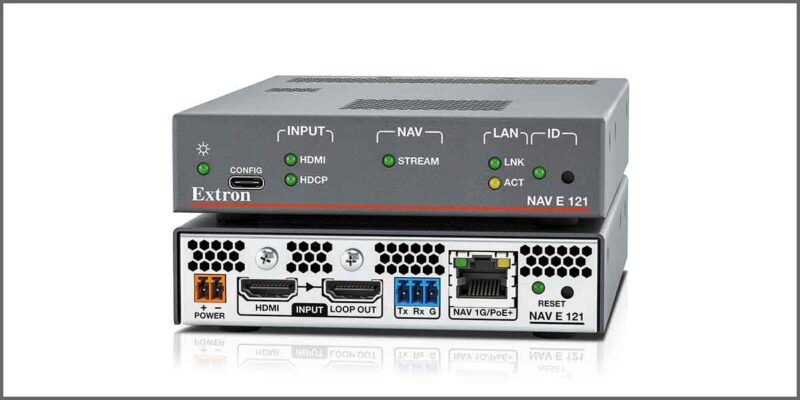The Value of Standardized Infrastructure
 By Justin Kennington
By Justin Kennington
President, SDVoE Alliance
HDBaseT has been a valuable technology for the pro AV industry, as it was the first to enable the reliable transmission of video with no quality degradation or latency over popular category cable. This is important because the ubiquity of category cable makes it an easy low-cost choice for installation.
Category cable is designed and specified by the Telecommunications Industry Alliance specification 568 (hereafter “TIA-568”) for datacom applications. TIA-568 defines a complete infrastructure system, including cable types (currently categories 1 through 7) as well as installation practices and techniques. HDBaseT takes advantage of category cables by making HDBaseT’s electrical characteristics as similar as possible to those of 10GBaseT (a format for 10 gigabit Ethernet over category cable).
Further, TIA-568 is part of a complete technology stack. While TIA-568 defines the physical infrastructure, it goes hand in hand with IEEE 802.3 (Ethernet) to fully define the so-called “media layers” (layers 1, 2, and 3) of the OSI network layer model.
The beauty of this technology stack is that every layer is fully defined, so higher layers don’t need to worry about how lower layers work. But this means that each layer must be implemented fully. So if any part of TIA-568 is ignored, reliable system operation can never be guaranteed. Even at low speeds, the best category 7 cable will not perform if terminated incorrectly. And at the limits of speed (10GBaseT today), performance to 100 meters is not guaranteed if proper rules for cable patching are not followed.
Unfortunately for HDBaseT, although it is similar to 10GBaseT Ethernet, it is not the same physical electronics layer. So some divergence in infrastructure requirements is to be expected. And while the infrastructure requirements for Ethernet are clearly laid out by TIA-568, the requirements for HDBaseT infrastructure are at best an ad hoc collection of empirical data collected by individual equipment manufacturers, who are focused on testing the specific limits of their own products and not on the development of a global standard.
The evidence for this is everywhere. HDBaseT makes demands on cable infrastructure at up to 350 MHz, yet claims compatibility with category 5e cable. A read of the TIA-568 definition of category 5e cable reveals that its performance is only specified to 100 MHz. Some category 5e cables may work with HDBaseT, but how can performance be guaranteed, if the specification doesn’t even address the speeds required? Nearly every major manufacturer of HDBaseT gear has created a detailed white paper explaining their very specific limitations on cable type and installation practice. These papers often contradict one another. Every product is different, and there are no stringent industry-wide standards for cable performance. This is not true for Ethernet — it has TIA-568!
This creates need for installers and integrators to be trained specifically by the manufacturer of the HDBaseT gear they want to use. This knowledge is not always transferable. Some manufacturers support HDBaseT to 70 meters, others to 100 meters. Some support 4K at only 40 meters. Does this gear work with Cat5e? Or will it require (or perhaps “strongly recommend”) Cat6a or even higher? These answers can only be found by studying individual product datasheets, or attending proprietary manufacturer training courses.
In the real world, it is far too expensive to send an army of technicians to days of training at each and every manufacturer. Worse, often the actual cable installation is performed by a third-party contractor instead of a trained AV technician. IT contractors are never trained on installing HDBaseT equipment — it’s not their world. They are datacom installers and TIA-568 is their Bible. They know the rules of TIA-568 by heart and know how to install and test physical infrastructure to those specifications. Sometimes this will work for your HDBaseT installation. Sometimes it will not. TIA says Cat5e cable works to 100 meters. What happens when you try to run a class B HDBaseT device across that length? (Nothing happens, that’s what).
You could try to retrain your cable contractor or explain the special rules they need to follow: “By the way, I need you to source a specific cable from a pro AV manufacturer, for whom you are not an authorized dealer.” Best case scenario, they will get a working infrastructure and charge you extra for the custom work. Worst case, they deliver a “tested” infrastructure that won’t handle HDBaseT. By contrast if you explain to your datacom contractor “I need a 10GBaseT infrastructure installed and tested,” they will know exactly what to do. They will source standard cable, install and test it, and leave you with a reliable and ready infrastructure at minimal cost.
It would be great if the AV industry could give up on “standards” that are as incomplete as HDBaseT, and instead take advantage of the complete technology stack represented by Ethernet and the corresponding installation guidelines set down by TIA-568. Today this is finally possible. With the recent momentum in the industry towards AV distribution over IP networks, we can finally start to leverage these all-encompassing standards for AV infrastructure design and quality. No more worry about whether this HDBaseT transmitter will be reliable on that “HDBaseT” cable. An Ethernet device is an Ethernet device (by specification!), and its cable requirements are well understood by an entire industry of trained installers.
Furthermore, because Ethernet allows us to quit worrying so much about the physical layer and infrastructure, we can spend more resources thinking higher up the OSI stack. The physical layer is not the place for an AV designer to add value! For that, we look to the top of the stack — the application layer. This is where software is used to define and create user experiences. The user experience is where a good AV designer sets himself apart, so why not focus there?
As industry momentum continues to move away from point-to-point technologies like HDBaseT and towards IP as a transport for AV signals, what we will see is convergence and more standardization. In fact, Ethernet, IP and other important networking standards provide us with everything needed to move bits from place to place. The next wave of AV technology will be standardized software platforms and hooks to control high level AV functions like switching, scaling and other processors. As we begin to think of these processing units, rather than boxes and wires, as fundamental building blocks, we can begin to build an industry where software defines the applications and user experience. This is the real power that Ethernet and its brother technologies bring. Look at all the other Ethernet-based platforms where software creativity runs wild — the smartphone, the web browser and consumer AV platforms like YouTube and Netflix.
The move to TIA-568 infrastructure is simply the foundation for a whole new world, where software defines the application and the AV industry’s creativity can finally be unleashed.
Justin Kennington is the president of the SDVoE Alliance. Previously he was director of strategic and technical marketing for AptoVision, a Montreal-based technology company that provides its advanced BlueRiver chipsets for AV-KVM signal extension, matrix switching, IP-based switching, video wall and multi-view applications. He was also formerly the technology manager of DigitalMedia at Crestron and is widely recognized as an influential technologist in professional AV. He received InfoComm’s Young AV Professional of the Year Award in 2014.





